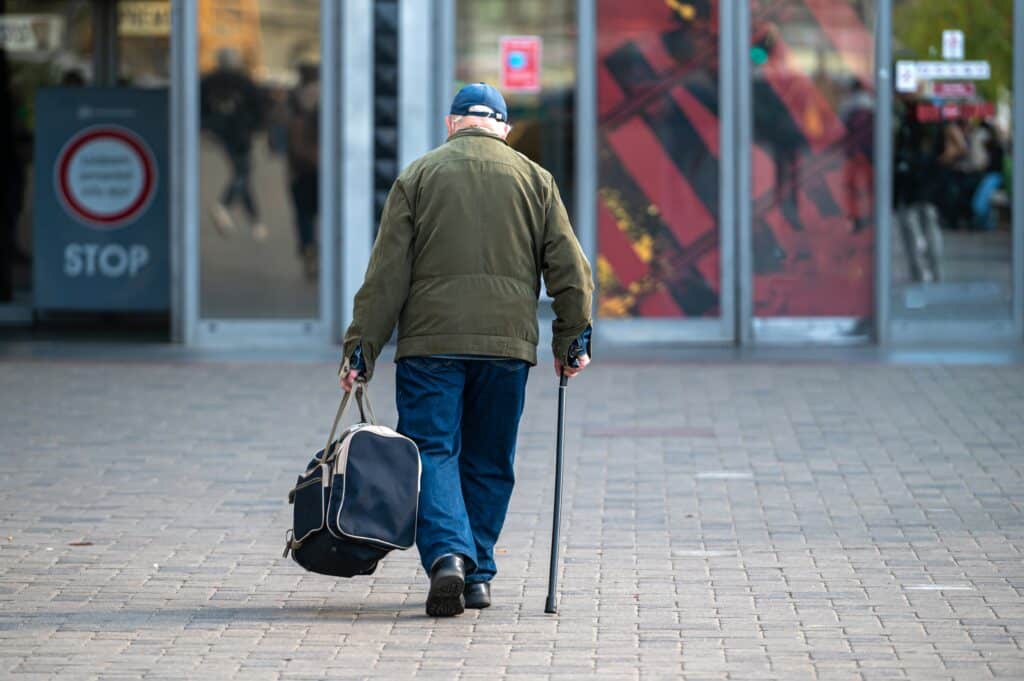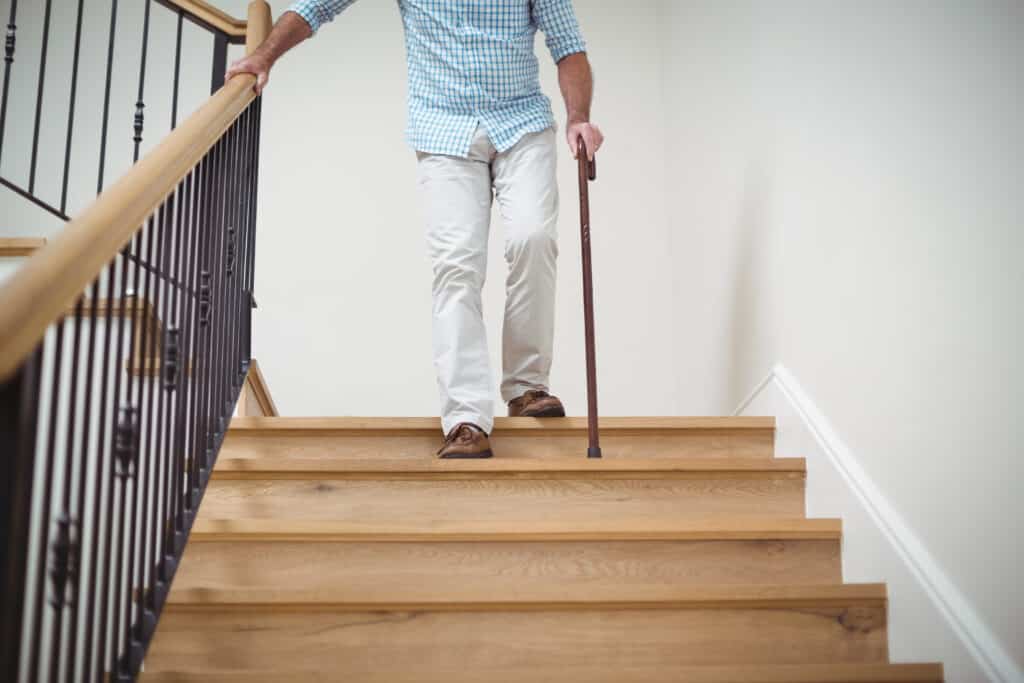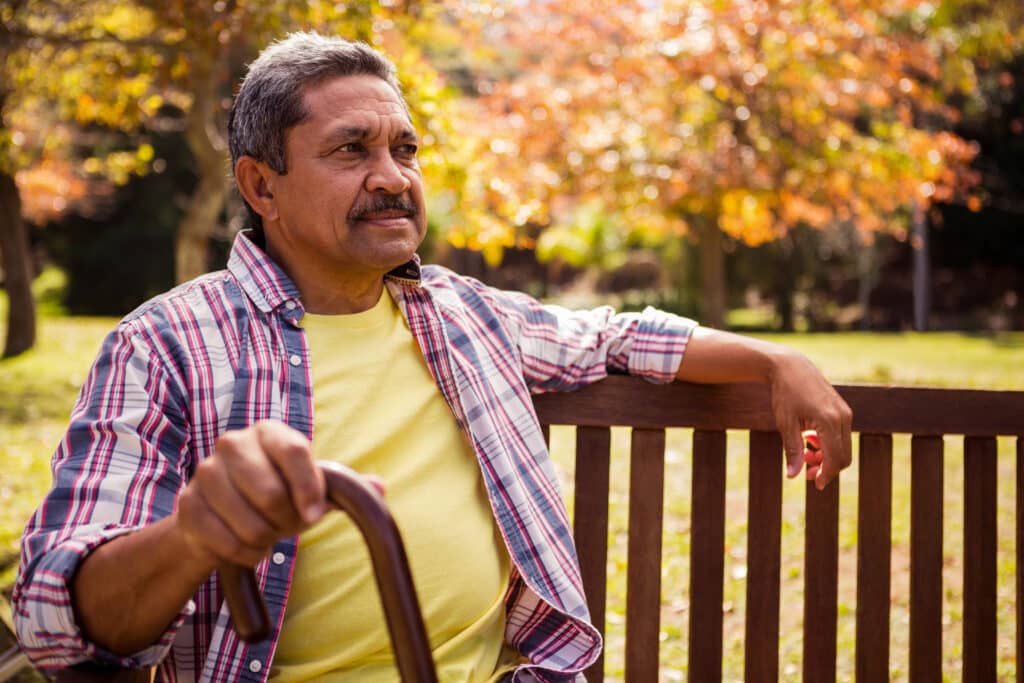If you’ve suffered an injury, had surgery, or are just a little off-balance, your doctor may recommend using a walking cane while you recover. Using a cane can help to take the weight off your weak leg, provide extra balance, and allow you to perform activities of daily living independently and safely.
Let’s discuss picking a cane that’s right for you and fitting it to your body, and we’ll review the basics of using it properly so you don’t injure yourself.
Types of Walking Canes and Grips
Despite their simplicity, canes are carefully designed to provide the best portable assistance for weight-bearing activities. They can help to reduce falls and provide support for a variety of injuries and conditions. Here are the most common types of canes for seniors:
- A standard cane is the most basic type of single-tip walking cane. Perfect for those who need a little bit of extra stability when walking and ideal for those who are at a slightly higher risk of falls.
- Quad canes have four tips, which provide a wider base of support. While quad canes may help prevent falls, they tend to be slightly awkward to use, so they might take a little more practice to get used to.
- An offset cane is designed to help those struggling to balance one side. The offset handle helps shift weight from the affected to the unaffected side, making walking easier.
- A folding cane is perfect for those who need a cane but don’t want to carry around a lot of extra weight. This type of cane folds up for easy storage and transport.
The Cane Grip
Choosing a comfortable cane will help prevent unnecessary stress on the muscles, bones, and joints of your hands and wrists.
The grip may be a factor if you have arthritis or some other condition that limits your grip strength. If you start to have pain, numbness, and/or tingling in your hands while using a cane, that grip may not be a good fit.
It is also worth mentioning that a wrist strap may work to your advantage in the event that you have grip strength issues.

How to Choose the Best Walking Cane for Your Needs
When choosing a cane, it is important to consider your personal needs and preferences.
The type of materials used in making your cane (carbon fiber or aluminum is lighter than many wooden canes, for example) can make a difference. Heavier canes can be more difficult to carry around, but they are more stable and less likely to tip over, while lighter canes are easier to transport but may not be as stable.
For example, if you encounter many uneven or icy surfaces, a quad cane may provide more stability and support. Alternatively, choose a folding or lightweight cane if you need a cane that can be easily transported or stored.
Be sure to ask your doctor or physical therapist for advice on which type of cane would be best for you and your lifestyle.

Fitting Your Walking Cane
It’s important that your cane is properly sized for your body. If it’s too long, it will take more effort to move it around, and if it’s too short, you’ll likely lean to the side, leaving you more susceptible to injury, and it might throw you off balance and increase your risk of falling.
Some canes are adjustable while others are not, to ensure a proper fit, look at the following:
- Elbow bend – When you place the cane in your hand, your elbow should be bent comfortably at about 15 degrees. If you’re using it to help improve your balance, your elbow may be bent slightly more.
- Wrist height – When you stand with your arms hanging straight at your sides, the top of your cane should be aligned with your wrist crease.
Holding Your Cane
If you’re using your cane due to an injury or weakness of your hip, leg, foot, etc., you should hold your cane in the hand opposite of your injured or weak leg. For example, if you’ve injured your left knee, you should keep your cane in your right hand, and vice-versa.
If you’re using your cane for balance because you’re unsteady on your feet, you should hold your cane in your non-dominant hand. For example, if you’re right-handed, you should hold your cane in your left hand, and vice-versa.

Using Your Walking Cane
Walking canes can present a unique set of challenges for some elderly people, and like other skills, walking with a cane can take a little bit of practice. Here are some guidelines on how to use your walking cane for various weight-bearing activities that might prove challenging at first.
Sitting and Standing
To sit in a chair with a cane:
- Back up into the chair until you feel the chair against the back of your legs.
- If using a standard cane, hold your cane in one hand and the armrest with your other hand while you ease yourself into the chair.
- If using a quad cane, place both hands on the armrests while you ease yourself into the chair.
To stand up from a chair with a cane, simply repeat this process in reverse, ensuring you feel stable on your cane before walking.

Walking with a Cane
To walk with a cane:
- Place your cane slightly in front and to the side of you.
- Step forward with your injured leg, and put your weight onto your cane.
- Then step forward, slightly past the cane, with your good leg.
- Repeat.
Using Stairs with a Cane
To walk up stairs with a cane:
- Grasp the railing with your free hand.
- Push your weight down into your cane.
- Step up onto the stair with your good leg.
- Then, step up with your injured/weak leg and lift your cane up.
- Repeat.
To walk down stairs with a cane:
- Position your cane on the step below.
- Step down with your injured/weak leg.
- Step down with your good leg.
- Repeat.
Note: if you’re using a larger quad cane, turning it sideways can help when using stairs.

Safety Tips for Using a Cane
When using a cane, it’s important to follow some basic safety tips to minimize your risk of slips and falls, including:
- Make sure always to look up, not down, at your feet.
- Wear flat, well-fitted shoes that provide good support.
- Be sure the rubberized tip of your cane is in good shape, and replace if it’s deteriorating.
- Use chairs with armrests to make transitioning between standing and sitting easier.
- Secure or remove loose carpets, cords, etc.
- Use caution on wet or slippery surfaces – wipe up spills in your home immediately.
- Arrange your furniture to provide clear pathways from one room to another.
- Apply treads to stairs to allow for better gripping.
- Ensure your rooms and stairs are well-lit.
- Install nightlights in areas you use in the middle of the night (i.e., bathroom, bedroom).
- Use bathroom aids such as non-slip bath mats, raised toilet seats, shower seats, grab bars, etc. to make transitioning around your bathroom easier.
- Keep items that you use frequently in your home within easy reach.
- It is also worth researching the best medical alert systems if you experience a fall while at home alone.
Key Takeaways
- Canes are recommended to maintain balance and stability for recovering from injuries or surgeries.
- There are various types of canes, including standard, quad, offset, and folding, each serving different needs and preferences.
- A comfortable grip is crucial; choosing the wrong grip can cause stress to hands and wrists, which is particularly important for those with arthritis or other conditions limiting grip strength.
- The right cane should be chosen based on individual needs, lifestyle, and the kind of surfaces encountered regularly; a physician’s advice is highly recommended in choosing the appropriate cane.
- The material of the cane matters; lighter canes like those made of aluminum or carbon fiber are easy to carry but may lack stability, while heavier canes offer stability but can be cumbersome.
- Proper sizing is crucial: the cane should align with the wrist crease when arms are hanging straight, and the elbow should be bent at a comfortable 15 degrees.
- The cane should be held in the hand opposite to the injured leg, and for balance issues, it should be held in the non-dominant hand.
- Safe usage of the cane is essential: the user should be cautious on wet or slippery surfaces, wear flat and well-fitted shoes, ensure the rubber tip is in good shape, and maintain a clear pathway at home.
- Additional safety measures like installing nightlights, using non-slip bath mats, securing loose carpets, and applying treads to stairs are recommended to avoid accidents.
- Practice and consultation with a healthcare provider are essential when starting to use a cane, as it might seem difficult initially but is crucial for mobility, independence, and safety in daily activities.
References:
- https://orthoinfo.aaos.org/en/recovery/how-to-use-crutches-canes-and-walkers/
- https://www.mayoclinic.org/healthy-lifestyle/healthy-aging/multimedia/canes/sls-20077060
- https://my.clevelandclinic.org/health/articles/15541-how-to-use-a-cane
- https://cham.org/HealthwiseArticle.aspx?id=zt1156
- https://medlineplus.gov/ency/patientinstructions/000343.htm








